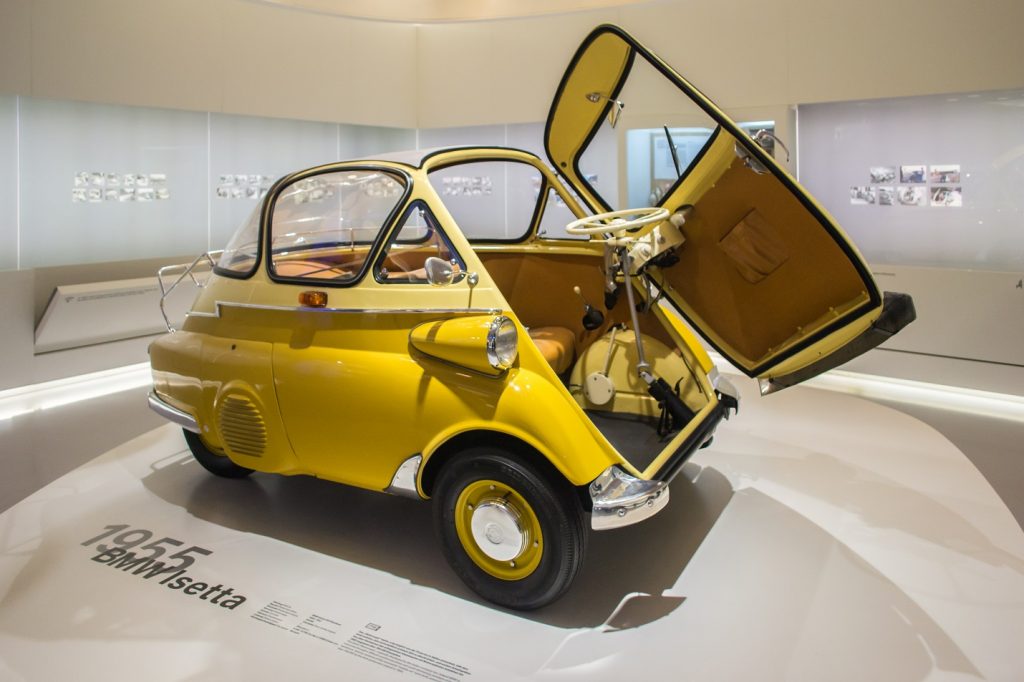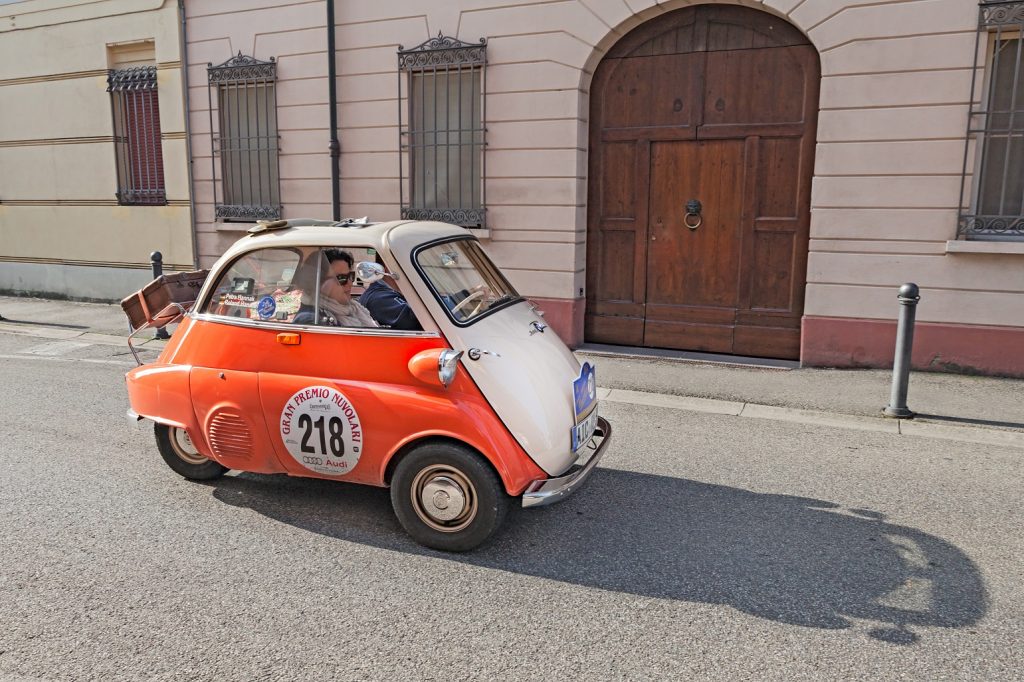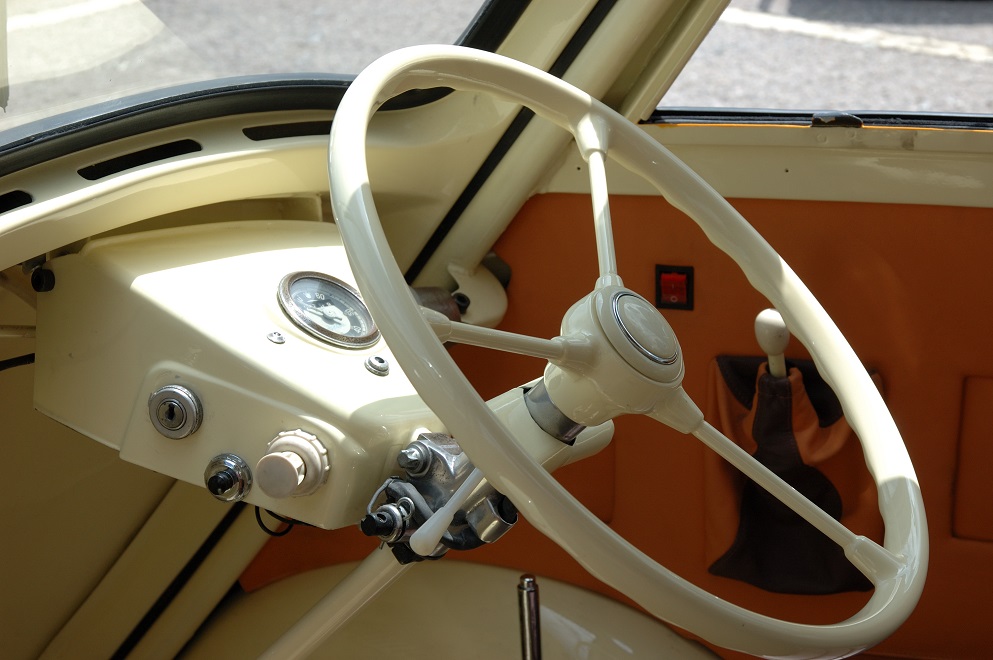If Dr. Seuss owned a car, we wager it would be the Italian-designed BMW Isetta. This microcar, built at one point or another by four different manufacturers, saw production in Argentina, Spain, Belgium, France, Brazil, Germany, and the United Kingdom. The tree-loving Lorax would be proud of the Isetta, too – it’s the first mass-produced car to achieve an astounding 78 U.S. miles per gallon (94 MPGs if measured in imperial units). Keep in mind, this was an achievement made in the early 50’s.

A 1955 BMW Isetta shows how the occupants enter and exit the vehicle.
A Quirky Sensation in Italy
The Iso Isetta – which translated into little Iso – was the invention of fridge, scooter, and three-wheeled truck builder Renzo Rivolta. Owner of Iso SpA, Rivolta put his designers to work to build a small car for mass production. Iso’s lead engineers, Ermenegildo Preti Pierluigi Raggi, kept the Isetta affordable by mating the compact chassis with the two-stroke motor from the company’s motorcycle, the Moto 200 – thus earning the car the name its name.

An Isetta shown participating an an historical rally, seating two passengers comfortably.
The car received critical acclaim during its unveiling in Turin in November 1953. No modern car had ever come so small yet functional. At just 7.5 feet long and 4.5 feet wide, the egg-shaped car and its bubble windows could still house one driver and passenger. Entering the vehicle meant lifting the entire hinged front end – which acted as the door – forward and away. The steering wheel and instrument panel were attached to the door. In the event of a front-end collision, occupants could exit through the Isetta’s canvas roof.
Power and Performance
Those words aren’t quite used in the same context as any other vehicle when describing the Isetta. The microcar made just 9.5 horses through its 236 cc engine, which transferred power to the rear wheels through a solid rear axle and chain drive connected to the gearbox. The powertrain featured a 4-speed manual transmission and took more than 30 seconds to accelerate from 0 to just 31 miles per hour.

The Isetta’s one-cylinder motor was off-set and transfered power via a chain drive.
That mattered little though, because the original Isetta was not meant to be a grand tourer or long-distance cruiser. Marketed to buyers in the cramped cities of Europe, the Isetta topped out at 47 miles per hour but afforded owners between 42 and 58 U.S miles per gallon. The Isetta was efficient enough to earn the top three spots in the economy class of the legendary 1,000-mile race, the Mille Miglia.
Production wouldn’t stay in Italy, though. Renzo Rivolta turned his attention to his sports car production and sold the Isetta to BMW in 1955 after making just 1,000 units.
The Bimmer Isetta
BMW took Rivolta’s design and improved upon it in every measure possible. The new Isetta gave up its Moto 200 motor in favor of BMW’s own four-stroke 247 cc engine, rated at 13 horses. Although similar in appearance, the Bimmer Isetta was so redesigned and re-engineered that it shared no interchangeable parts with an Italian make.

The Isetta was so popular that BMW built the Isetta 600, a 4-seater passenger car.
BMW also dramatically improved the powertrain, adding unusual cardan joints and shafts, made of rubber, to the transfer unit. The result was a four-speed gearbox that was free of chain tension and well-insulated, reducing noise, vibration, and harshness that the original car suffered.
The BMW Isetta saw a tenfold increase in production, with 10,000 units produced in just eight months. In 1956, Germany revamped its motorcycle licensure and disallowed motorcyclists from operating the Isetta. BMW saw the writing on the wall and upped the power of the Isetta to accommodate drivers with standard motor vehicle licenses, who wanted more performance.
The result was the BMW Isetta 300, which sported a 298 cc motro and a top speed of 53 miles per hour. The vehicle’s iconic bubble windows were also replaced with more conventional (and functional) flat-plane sliding windows.
Popularity to Rarity
Between Bimmer’s acquisition of the Isetta and its improvements to the model, popularity grew for the microcar. A total of 161,360 BMW Isettas would be produced between 1956 and 1962, with production expanding to Isetta of Great Britain. The BMW Isetta would revert to its motorcycle-licensure roots in the U.K., receiving a single rear wheel to allow motorcyclists to operate the vehicle.

The Isetta’s steering column and instruments swung away with the door.
Today, BMW Isettas continue to climb in collectability. Many late 50’s models command prices in the mid-teens and low twenties, with values rising and availability diminishing. Many have been brought stateside for auction – though you should expect to pay even more for a U.S.-available Isetta.
